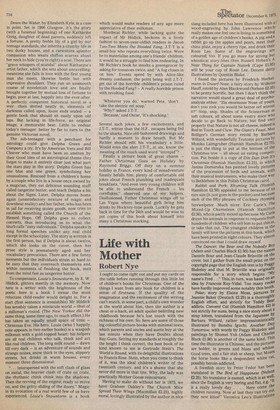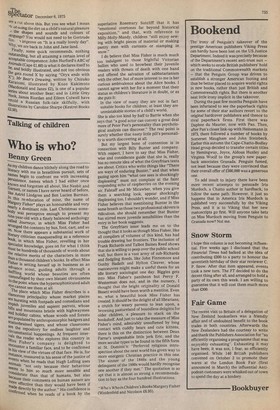Life with Mother
Robert Nye
I ought to come right out and put my cards on the table before running through this little lot of children's books for Christmas. One of the things I want from any book for children is a sense of firstness. If the quality of the imagination and the excitement of the writing can't match, in some part, a child's own wonder at the world .about him, then the author is a cheat or a hack, an adult spoiler belittling new childhoods because he's lost touch with the richness of his own. So: here are some of those big colourful picture-books with minimal texts, which parents and uncles and aunts buy at the last minute when they have Doubts about Ray-Guns. Setting my standards at roughly the the height I think correct, the best book of its kind known to me is Gertrude Stein's The World is Round, with its delightful illustrations by Francis Rose. Stein, when you come to think of it, was the ideal children's writer of the twentieth century, and it's a shame that she never did more in that line. Why, the lady was practically Mother Goose reincarnate.
Having to make do without her in 1975, we have Graham Oakley's The Church Mice Spread Their Wings (Macmillan £2.25), highly moral, lovingly illustrated by the author in nice slang included here has been illustrated with a wood-engraving by John Lawrence which really makes one feel one is living in something of a golden age of children's books. A pig and ,a rabbit go up the apples and pears, meet their china plate, enjoy a cherry ripe, and drink their Rosie Lee. Some of the engravings are coloured, too. If you go , more for strong but whimsical story-lines then Russell Hoban's A Near Thing for Captain Najoriz (Cape £1.95) will be your cup of Rosie Lee. Decent dotty illustrations by Quentin Blake. I found the pictures by Friedrich Hechelmann in Dwarf Nose, a fairy story by Wilhelm Hauff, retold by Alan Blackwood (Nelson £2.35) to be pretty horrific, but then I don't think the narrative would stand a great deal of psychoanalysis either. "Zis enormous Nose of yours, don't you zink you would be better orf wizout it?" Snip, snip. Shades of the Scissorman in soft colours, all about some vestry mice who decide to go Back to Nature, but find very properly that Nature is not all cheese, indeed is Red in Tooth and Claw, .The Giant's Feast, Max Bolliger's German story retold by Barbara Willard, with wonderfully Teutonic pictures by Monika Laimgruber (Hamish Hamilton £2.75)• is just the thing to put at the bottom of the Christmas tree — all about an eating competition. Put beside it a copy of Din Dart Don It's Christmas (Hamish Hamilton £2.25), in which Janina Domanska has painted lovely pictures of the procession of birds and animals, with their musical instruments, who make their way to Bethlehem in this Polish Christmas carol.
Rabbit and Pork: Rhyming Talk (Hamish Hamilton £2.50) appealed to me because of its nice size (it just goes in the pocket) and because each of the fifty phrases of Cockney rhyrning StreWelpeter. Much nicer: Eric Carle's The Mixed-Up Chameleon (Hamish Hamilton £2.50), who is partly mixed up because Mr Carle draws his animals in response to requests from hundreds of children who tell him to put this in, or take that out. The youngest children in the family will love the pictures in this book, which have been printed in eight colours. They almost convinced me that I could draw myself.
The Dancer, the Bear and the Nobody (Adam and Charles Black £1.95) has the names Daniele Bour and Jean-Claude Brisville on the cover, but I gather from the small print On the copyright page that the English text is by Pegg Blakeley and that M. Brisville was original)' responsible for a story which begins "la name's Fred ..." This, in turn, was based on all idea by Francois Ruy-Vidal. Too many cooks have hardly improved some notably thin broth. Polar, story by Elaine Moss, pictures bY Jeannie Baker (Deutsch £2.25) is a thoroughlY English effort, and strictly for Teddy Bee? addicts. Convent Cat (Hamish Hamilton £2) 's not strictly for nuns, being a nice story about a stray kitten, translated from the Japanese bY Barbara Willard, rather impressionistically illustrated by Bunshu Iguchi. Another DaY, Tomorrow, with words by Peggy BlakeleY an paintings by Shomei Yoh (Adam and Charles Black £1.90) is another of the same kind. This time the illustrator is Chinese, and the pictures are bolder, in greens and blues and whites.
Good trees, and a fair stab at sheep, but Moses the horse looks like a despondent white rat, possibly heroin-addicted. A Swedish story by Peter Fedor has been
translated in The Bird of Happiness (Nelson f2.25). No translator is named, which is as Well, since the English is very boring and flat, e.g. "It
is a really lovely day . . Here come the
children running. Now at last they can trY °tit their new kites!" Veronica Leo's illustrations are a cut above this. But you see what I mean lb ,tit uoing the dirt on a child's natural pleasure .1 the shapes and sounds and colours of anguage? You would not need to be Gertrude Ste! I improve on "It is a really lovely day". Why, we are back in John and Jane land. Finally, some quick recommends, nothing outstanding, but all attaining a certain level of acceptable competence: John Hurford's ABC of Ananats (Cape £1.60) is what it declares itself to be, and boldly illustrated, and not too obvious (he gets round X by saying "Oryx ends with X"); Mr Bear's Drawing, written by Chizuko Karatomi, illustrated by Kozo Kakimoto (Macdonald and Janes £2), is one of a popular ,,,series about another Bear; and in Little Grey Neck James Riordan and Eileen Colwell have retold a Russian folk-tale skilfully, with illustrations by Caroline Sharpe (Kestrel Books .£2.5o).


































 Previous page
Previous page